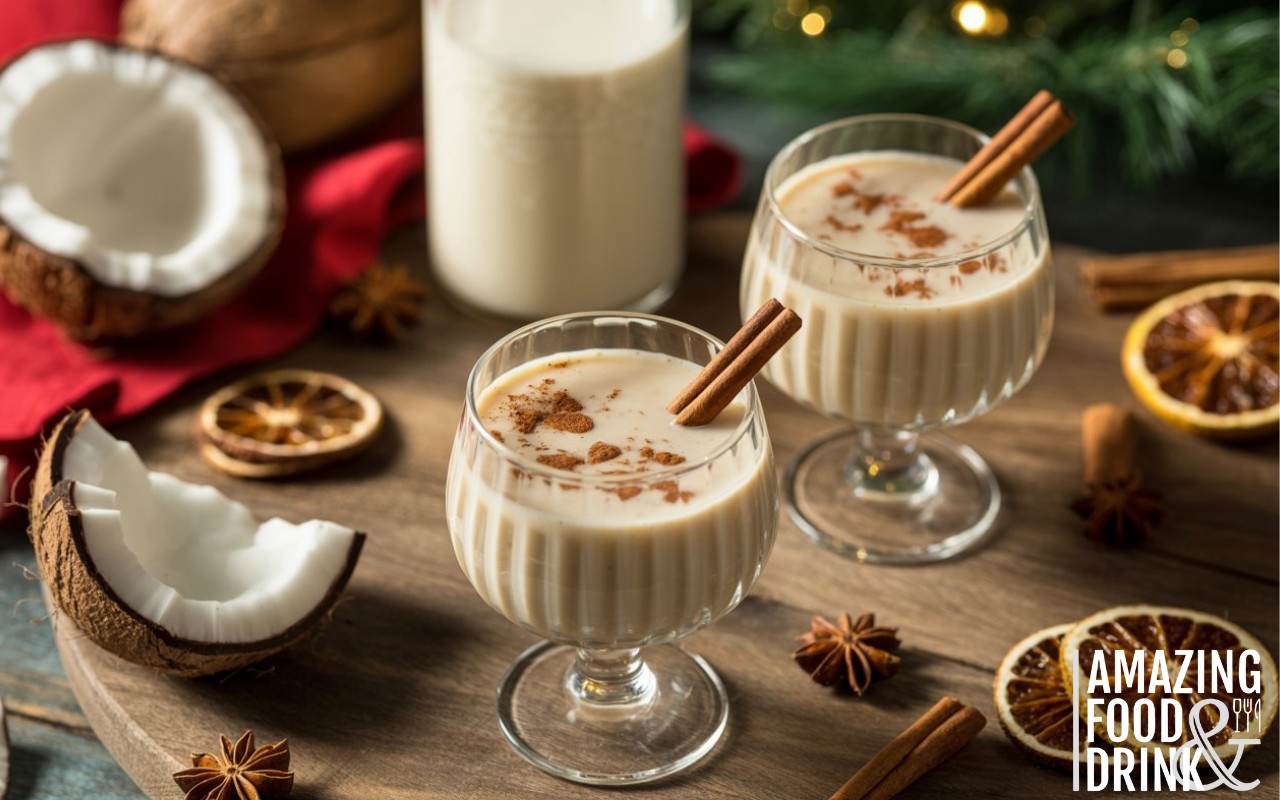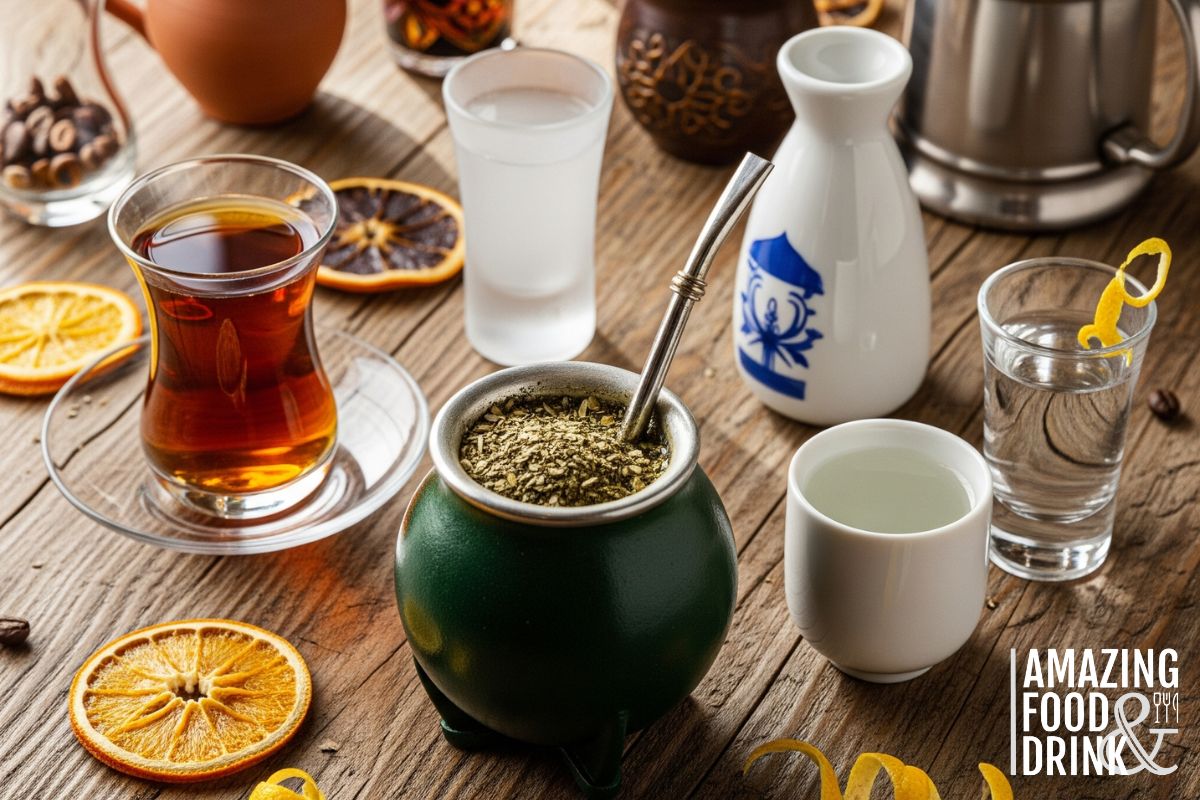Traditional coquito contains dairy, but this creamy dairy-free version delivers the same rich, spiced flavour using coconut milk. Perfect for those with lactose intolerance or following a plant-based diet, this Puerto Rican holiday drink takes just 10 minutes to prepare and tastes incredibly authentic. Whether you’re hosting Christmas dinner or planning a New Year’s Eve celebration, this vegan coquito ensures everyone can enjoy the festivities.
Having experimented with numerous dairy-free holiday cocktail recipes over the past decade, I’ve discovered that full-fat coconut milk creates the most luxurious texture while maintaining that signature coquito richness. The secret lies in balancing the cream of coconut with dairy-free condensed milk—a combination that rivals any traditional recipe.
Table of Contents
- What Is Dairy-Free Coquito?
- Ingredients & Substitutes
- Cooking Instructions
- Storage & Serving Tips
- Dairy-Free vs Traditional Coquito
- Customising Your Coquito
- Troubleshooting Common Issues
- Jump to Recipe
What Is Dairy-Free Coquito? (Does Coquito Have Dairy?)

Dairy-free coquito transforms the beloved Puerto Rican holiday beverage into a plant-based celebration drink. Traditional coquito relies heavily on evaporated milk, condensed milk, and sometimes heavy cream, making it unsuitable for those avoiding dairy products. This lactose-free version maintains the same creamy consistency and warming spices while catering to vegan diets and lactose-intolerant individuals.
The magic happens when you substitute dairy ingredients with coconut-based alternatives. Full-fat coconut milk replaces evaporated milk, dairy-free condensed coconut milk adds sweetness, and cream of coconut provides that essential richness. The result? A coquito that’s indistinguishable from the original, but completely plant-based.
Unlike traditional eggnog recipes, dairy-free coquito doesn’t require raw eggs, making it safer for pregnant women and young children. The coconut base also adds beneficial medium-chain triglycerides, making this festive drink slightly more nutritious than its dairy-laden counterpart.
Dairy-Free Coquito Ingredients & Substitutes
Creating the perfect vegan coquito requires specific ingredients that work harmoniously together. Understanding each component’s role helps you make informed substitutions and achieve professional-quality results every time.
The Coconut Foundation

The secret to exceptional dairy-free coquito lies in layering different coconut products, each contributing unique properties that work together to create complexity and richness.
Full-fat coconut milk provides the base richness, while cream of coconut adds sweetness and body. Dairy-free condensed milk bridges these elements, creating complexity that rivals traditional dairy versions. Choose high-quality brands for optimal results—Aroy-D and Blue Dragon produce consistently excellent full-fat coconut milk with proper fat separation.
For condensed alternatives, Nature’s Charm and Alpro deliver authentic sweetness and texture that closely mimics traditional condensed milk. Avoid light coconut milk entirely, as the reduced fat content creates thin, disappointing results that lack the luxurious mouthfeel essential to proper coquito.
Refrigerating coconut milk overnight allows natural separation. Use the thick cream that rises to the top for maximum luxury, reserving the liquid for thinning if needed. This technique mirrors how professional bartenders handle coconut cream in premium cocktails.
Spice Selection Matters

The warming spices define coquito’s character and distinguish it from generic coconut drinks, making careful selection crucial for authentic results.
Ceylon cinnamon offers superior sweetness and complexity compared to common cassia cinnamon. This premium variety provides the delicate warmth that defines exceptional coquito. Toast whole cinnamon sticks briefly in a dry pan before grinding for enhanced depth and aromatic complexity.
Freshly grated nutmeg transforms this drink from good to extraordinary. Pre-ground versions lose volatile oils quickly, resulting in a flat flavour that compromises the final product. Invest in whole nutmegs and a microplane grater – the difference becomes immediately apparent in such a simple recipe.
Vanilla extract quality directly impacts the final result. Madagascar vanilla provides the richest profile with complex floral notes, whilst artificial essence tastes harsh and synthetic. For special occasions, scrape seeds from half a vanilla pod directly into the mixture for visual appeal and intensified flavour.
Enhancement Options

Beyond the essential ingredients, several additions can customise your dairy-free coquito to personal preferences and dietary requirements.
Plant-based milk additions allow consistency customisation without compromising flavour. Barista-style oat milk and cashew milk create silkier textures than regular versions, whilst maintaining the rich coconut profile that defines exceptional coquito.
Add these enhancements gradually during blending. Obtaining proper thickness requires patience and frequent tasting. The goal is a consistency that coats the back of a spoon but pours smoothly into glasses.
For an extra tropical character, consider adding a splash of coconut extract or additional vanilla. These flavour boosters enhance the natural coconut elements without overwhelming the delicate spice balance that makes coquito so special.
How to Make Dairy-Free Coquito (Step-by-Step)
This lactose-free coquito recipe requires minimal effort but maximum attention to ingredient quality. The blending technique determines final texture, so patience rewards you with professional results that rival any restaurant version.
Equipment Setup

Before beginning, ensure you have a high-powered blender capable of creating silky smooth textures that define exceptional coquito.
Vitamix and NutriBullet models work brilliantly for this application. You’ll also need a large pitcher with a tight-fitting lid for storage, a fine-mesh sieve for straining, and a small saucepan if you choose to bloom your spices for enhanced flavour.
Having all ingredients at room temperature (except the coconut milk) creates easier blending and better incorporation. Cold ingredients resist mixing and can create lumpy textures that require additional processing to smooth out.
Building the Coconut Base

The foundation of exceptional dairy-free coquito lies in properly combining the various coconut products, ensuring each element contributes its unique properties without overwhelming the others.
Start by opening your refrigerated coconut milk can. The thick cream that has separated to the top provides maximum richness, whilst the liquid beneath can thin the mixture if needed. This natural separation actually benefits the recipe by giving you control over the final consistency.
Combine the condensed coconut milk, cream of coconut, and thick coconut cream in your blender. The order matters less than ensuring complete incorporation. Blend on high speed for a full minute – this extended blending creates the smooth, professional texture that distinguishes homemade coquito from commercial versions.
Spice Integration Techniques

Spices define coquito’s character, and proper integration determines whether they enhance or overpower the delicate coconut flavours that form the drink’s foundation.
Two methods work effectively: direct addition or blooming for intensified flavour. For blooming, heat cinnamon and nutmeg with two tablespoons of water in a small saucepan over medium heat. This technique releases essential oils and creates more complex flavour compounds.
After three minutes of gentle heating, strain the aromatic liquid directly into your blender, discarding the solid spices. Alternatively, add ground spices directly to the blender with vanilla extract. This simpler method works perfectly for weeknight preparations when time is limited.
Achieving Perfect Consistency

The ideal dairy-free coquito coats a spoon lightly but pours smoothly without feeling heavy, requiring careful attention to texture development throughout the process.
Consistency preferences vary, so taste and adjust gradually. If the mixture feels too thick, add plant-based milk in small increments whilst blending. Remember that chilling thickens the mixture significantly as coconut fats solidify when cold, creating additional body.
What seems slightly thin at room temperature often achieves perfect consistency after proper chilling time. This natural thickening process contributes to the luxurious mouthfeel that makes coquito so appealing.
Final Blending and Straining

After incorporating all ingredients, blend for an additional 30 seconds to ensure complete integration and optimal texture development.
Pour the mixture through a fine-mesh sieve into your serving pitcher. This step removes any undissolved spice particles and creates the silky smoothness that professional coquito demands. Press any solids in the sieve with the back of a spoon to extract maximum flavour whilst maintaining smooth texture.
Flavour Development

The magic happens during chilling, when individual flavours meld into the complex, harmonious profile that defines exceptional coquito.
Refrigerate your dairy-free coquito for at least four hours, though overnight chilling produces superior results. During this time, flavours meld and develop complexity whilst coconut fats create natural richness that improves with time.
Taste after the initial chilling period and adjust seasonings if needed. Sometimes, additional vanilla or a pinch more cinnamon enhances the final product. The beauty of homemade coquito lies in this customisation opportunity.
Vegan Coquito Storage & Serving Tips
Proper storage and presentation elevate this dairy-free holiday drink from homemade to professional quality. Understanding how coconut-based ingredients behave ensures consistently perfect results every time you serve this festive beverage.
Storage Guidelines

Coconut-based beverages require specific storage considerations to maintain optimal texture and flavour throughout their shelf life.
Refrigeration Storage
Store your lactose-free coquito in an airtight glass container for 3-5 days for maximum freshness. Coconut fats may separate—this indicates quality ingredients, not spoilage. Simply stir vigorously before serving to restore smoothness.
Glass containers prevent the absorption of refrigerator odours that can compromise delicate coconut flavours. Avoid plastic storage, which can impart unwanted tastes and allow flavour transfer from other refrigerated items.
Freezing for Extended Storage
Pour into freezer-safe containers, leaving 2cm headspace for expansion during the freezing process. Thaw overnight in the refrigerator, then blend briefly to restore texture. Frozen coquito maintains its creamy consistency beautifully when properly thawed and reblended.
Batch Preparation Benefits
Double or triple recipes for holiday entertaining needs. Large batches actually improve in flavour as ingredients have more time to meld together. Store in multiple smaller containers rather than one large vessel for easier serving and portion control.
Serving Suggestions

Presentation transforms homemade coquito into an impressive holiday centrepiece that guests will remember long after the celebration ends.
Classic Presentation Style
Serve in chilled glasses with cinnamon stick stirrers for authentic Puerto Rican styling. Dust the rim with ground cinnamon mixed with coconut sugar for extra festivity. The contrast between creamy white coquito and warm brown cinnamon creates an Instagram-worthy presentation.
Tropical Garnish Options
Fresh pineapple wedges, toasted coconut flakes, or candied ginger add visual appeal and complementary flavours. Star anise pods float beautifully and release subtle liquorice notes that enhance the existing spice profile without overwhelming the delicate balance.
Temperature Considerations
Serve slightly chilled rather than ice-cold to allow flavours to shine through properly. If adding ice, use large cubes that melt slowly to avoid dilution. Alternatively, freeze coconut milk in ice cube trays for flavour-enhancing ice that won’t water down your creation.
Dairy-Free vs Traditional Coquito: Key Differences
Understanding how plant-based ingredients compare to dairy versions helps you appreciate why this dairy-free adaptation works so brilliantly. The nutritional and flavour profiles differ subtly but meaningfully, often resulting in superior final products.
Ingredient Transformation Analysis

Traditional coquito depends on evaporated milk for body, condensed milk for sweetness, and heavy cream for richness, with each dairy component contributing specific properties that plant-based alternatives must successfully replicate.
Evaporated Milk Replacement
Evaporated milk provides protein structure and mild sweetness in traditional recipes. Full-fat coconut milk offers similar richness with added tropical notes that enhance the Caribbean theme. The coconut flavour doesn’t overpower—it complements the existing coconut elements beautifully, creating more cohesive flavour profiles.
Condensed Milk Substitution
Both versions deliver concentrated sweetness and syrupy texture essential for proper coquito consistency. Dairy-free condensed coconut milk often tastes slightly less cloying than traditional versions, allowing other flavours to shine through more clearly. The plant-based version also contains beneficial lauric acid from coconuts.
Heavy Cream Alternative
Heavy cream adds fat and mouthfeel in conventional recipes. Cream of coconut provides similar richness plus natural sweetness, reducing the need for additional sugar. The result is actually a more complex flavour than traditional versions, with a better balance between sweet and creamy elements.
Nutritional Advantages

This lactose-free coquito offers several health benefits over traditional recipes, making it an excellent choice for health-conscious holiday celebrations.
Coconut milk contains medium-chain triglycerides (MCTs) that metabolise differently than dairy fats, potentially supporting energy levels and metabolism. Those with lactose intolerance can enjoy this festive beverage without digestive concerns that often plague dairy-based holiday drinks.
The plant-based version also avoids dairy hormones and antibiotics present in conventional milk products. For those following a vegan lifestyle, this recipe ensures no animal products compromise their dietary commitments whilst maintaining festive tradition.
Flavour Profile Enhancement

Dairy-free coquito actually tastes more coconut-forward, which enhances rather than detracts from the overall experience and creates more authentic tropical character.
The tropical notes complement spices beautifully, creating a more cohesive flavour story that tells the tale of Caribbean heritage. Traditional versions can sometimes taste heavy or cloying due to dairy richness, while the plant-based alternative feels lighter while maintaining richness.
This enhanced coconut presence also pairs better with traditional Puerto Rican dishes and tropical desserts, creating more harmonious menu combinations for authentic cultural celebrations.
Customising Your Plant-Based Coquito

Personalising this dairy-free recipe allows you to create signature versions tailored to different preferences and dietary needs. Small adjustments can dramatically change the final result, making each batch uniquely yours.
Sweetness and Spice Variations
Simple modifications can transform your coquito whilst maintaining its essential character and appeal.
- Sweetness Adjustments: Replace some condensed milk with unsweetened coconut milk and add stevia or monk fruit for blood sugar management. Maple syrup creates caramel notes, whilst agave provides neutral sweetness. Date syrup adds subtle fruit undertones that enhance the tropical character.
- Spice Blend Options: Caribbean heat comes from ground allspice and fresh ginger, creating authentic island warmth. Winter versions benefit from cloves, cardamom, and black pepper for cosy comfort. Vanilla bean seeds provide premium enhancement with visual appeal and superior flavour depth that elevates any gathering.
Troubleshooting Common Dairy-Free Coquito Issues

Even experienced cooks encounter challenges when adapting traditional recipes to plant-based versions. Understanding common problems and solutions ensures consistent success with every batch you create.
Quick Fixes for Common Problems
Coconut-based ingredients behave differently from dairy products, but simple techniques can resolve most issues quickly and effectively.
- Consistency Issues: Thick coquito responds well to gentle warming in a bowl of warm water, followed by thorough stirring. For a thin texture, refrigerate overnight to allow coconut fats to firm naturally. Grainy mouthfeel indicates insufficient blending—strain and reblend for two minutes at a minimum.
- Flavour Balance: Overpowering coconut taste balances with additional vanilla and spices. Under-seasoned mixtures benefit from toasted whole spices and longer chilling time. Adjust sweetness gradually with condensed milk or unsweetened plant milk as needed.
- Storage Solutions: Coconut products naturally separate—simply stir before serving. Store in glass containers only to prevent off-flavours and ensure tight sealing to maintain optimal taste throughout storage.
Nutritional Benefits of Dairy-Free Coquito
Understanding the nutritional profile of this plant-based version helps you make informed choices about portion sizes and frequency of consumption. While still a treat, dairy-free coquito offers advantages over traditional versions.
Health Advantages Overview
Coconut milk provides beneficial MCTs that metabolise differently than dairy fats, whilst avoiding lactose and casein proteins that cause digestive issues for many people.
- Nutritional Advantages: Full-fat coconut milk provides beneficial saturated fats in the form of MCTs that offer unique metabolic benefits compared to traditional dairy fats. These fats metabolise differently from long-chain fatty acids, potentially supporting energy levels and metabolism in ways that dairy fats cannot. Coconut milk also contains potassium, magnesium, and iron – minerals often lacking in dairy-based versions that rely primarily on milk products for nutrition.
- Digestive Health Benefits: Those with lactose intolerance can enjoy this festive drink without the bloating, gas, or digestive discomfort associated with dairy consumption during holiday celebrations. The absence of casein protein also benefits individuals with dairy protein sensitivities that can cause inflammation and digestive issues.
- Allergen Accommodation: This dairy-free recipe naturally avoids the top allergens found in traditional coquito preparations, making it accessible to broader audiences during holiday gatherings. The recipe excludes milk proteins and lactose whilst remaining naturally gluten-free and suitable for most dietary restrictions.
Pairing Dairy-Free Coquito with Holiday Foods

The rich, spiced flavour profile of lactose-free coquito complements numerous holiday dishes. Understanding these pairings helps you plan cohesive menus that showcase this festive drink.
Food Pairing Essentials
Strategic food combinations enhance both the coquito and accompanying dishes, creating memorable dining experiences for holiday gatherings.
- Caribbean and Latin Pairings: Serve alongside jerk chicken or empanadas for authentic cultural harmony. The cooling coconut balances spicy heat whilst maintaining traditional flavour profiles. Rice and peas, fried plantains, and tres leches cake create complete cultural experiences.
- Modern Fusion Options: Dairy-free coquito surprisingly complements British Christmas pudding and mince pies. The tropical spices enhance dried fruits and create unexpected but delightful fusion experiences. Pair with vegan cheese selections and tropical fruits for sophisticated presentations.
- Dessert Combinations: The coconut and vanilla notes enhance dark chocolate desserts beautifully. Tropical fruit salads, pineapple upside-down cake, and coconut flan create cohesive themes that feel intentional and sophisticated.
Make-Ahead Tips for Holiday Entertaining

Planning ahead ensures your dairy-free coquito is ready when guests arrive, allowing you to focus on other hosting responsibilities. These professional tips help you prepare efficiently whilst maintaining quality.
Preparation Strategies
Smart advance planning transforms holiday hosting from stressful to enjoyable, ensuring your dairy-free coquito impresses every guest.
- Batch and Storage Methods: Make large batches on Sunday for weeknight entertaining throughout busy December schedules. Store in individual serving bottles for convenience when unexpected guests arrive. Prepare the base mixture and freeze it in ice cube trays, then thaw the desired portions as needed.
- Serving Setup: Create interactive coquito bars with base drink, garnishes, and flavour additions. Keep pitchers in ice-filled containers for proper temperature maintenance. Pre-cut cinnamon sticks and grate fresh nutmeg up to three days ahead for maximum efficiency.
- Quality Timeline: Flavours develop over 4-24 hours, so taste at different intervals to understand preferred timing. Some prefer bright, fresh taste after four hours, whilst others favour mellow complexity after overnight chilling.
Creative Uses for Leftover Dairy-Free Coquito

Transform remaining coquito into exciting new treats that extend your holiday celebration beyond the initial serving. These creative applications prevent waste whilst providing delicious variations.
Creative Recipe Extensions
Leftover coquito becomes the foundation for numerous breakfast and dessert innovations that surprise and delight family members.
- Breakfast Applications: Substitute regular milk in pancake batter with dairy-free coquito for tropical morning treats. Mix with rolled oats, chia seeds, and vanilla for luxurious overnight oats that feel like dessert whilst providing nutritious breakfast options.
- Dessert Transformations: Churn leftover coquito in an ice cream maker for instant frozen dessert requiring no additional ingredients. Use instead of coffee in tiramisu for tropical adaptation with dairy-free mascarpone. Both applications showcase creativity whilst preventing waste.
- Beverage Variations: Warm gently and mix with strong coffee for cosy winter lattes. Blend with frozen tropical fruits and spinach for nutritious green smoothies that taste like holidays whilst supporting health goals.
Frequently Asked Questions
Does traditional coquito contain dairy?
Yes, traditional coquito relies heavily on dairy ingredients, including evaporated milk, condensed milk, and sometimes heavy cream or egg yolks. These ingredients create the characteristic creamy texture but make the drink unsuitable for those with lactose intolerance or following a vegan diet.
How does dairy-free coquito compare to the original?
This plant-based version tastes remarkably similar to traditional coquito, with some arguing it’s actually superior. The coconut milk base enhances the tropical flavour profile whilst eliminating digestive concerns. The texture remains rich and creamy, and the spice balance is identical to authentic recipes.
Can I make coquito without dairy and still keep it traditional?
Absolutely. This dairy-free adaptation maintains all traditional flavour elements – coconut, cinnamon, nutmeg, and vanilla. The only changes are ingredient sources, not flavours. Many Puerto Rican families now prefer plant-based versions for health and dietary reasons.
What makes dairy-free coquito creamy without milk?
Full-fat coconut milk and cream of coconut provide the essential richness and body. These ingredients contain natural fats that create a similar mouthfeel to dairy products. The combination of different coconut product textures mimics the complexity of traditional dairy-based recipes.
Is this vegan coquito suitable for children?
Yes, this dairy-free coquito makes an excellent holiday treat for children. However, coconut is technically classified as a tree nut allergen, so check with parents about coconut allergies before serving. The spices are mild enough for most children’s palates, and the creamy sweetness appeals to young taste buds.
How long does homemade dairy-free coquito keep?
Store in the refrigerator for 3-5 days in an airtight container. The drink may separate slightly – this indicates quality ingredients rather than spoilage. Simply stir before serving to restore smoothness and optimal texture.
Creating memorable holiday experiences often depends on small touches that show thoughtfulness and care. This dairy-free coquito recipe ensures everyone can participate in festive traditions regardless of dietary restrictions. The plant-based adaptation doesn’t compromise on flavour or texture—it enhances the tropical character that makes coquitos so beloved.
Whether you’re accommodating guests with lactose intolerance, following a vegan lifestyle, or simply curious about plant-based alternatives, this recipe delivers professional-quality results with minimal effort. The key lies in understanding how coconut-based ingredients behave and allowing sufficient time for flavours to develop properly.
Recipe Card: Dairy-Free Coquito

Prep Time: 10 minutes
Chill Time: 4 hours minimum
Total Time: 4 hours 10 minutes
Serves: 8-10 glasses
Difficulty: Easy
Ingredients
Coconut Base:
- 1 can (400ml) full-fat coconut milk, chilled overnight
- 1 can (397ml) dairy-free sweetened condensed coconut milk
- 1 can (425ml) cream of coconut
Spices:
- ½ teaspoon ground cinnamon
- Pinch of fresh ground nutmeg
- 1 teaspoon pure vanilla extract
Optional:
- 125-250ml unsweetened plant-based milk (for thinning)
- Extra cinnamon and nutmeg for garnish
- Cinnamon sticks for serving
Method
- Prepare base: Add condensed coconut milk, cream of coconut, and thick coconut cream (from separated can) to blender. Blend on high for 60 seconds until smooth.
- Add spices: Incorporate cinnamon, nutmeg, and vanilla extract. Blend for 30 seconds.
- Adjust consistency: If too thick, gradually add plant-based milk whilst blending until the desired consistency is achieved.
- Strain: Pour through a fine-mesh sieve into a serving pitcher for silky smoothness.
- Chill: Refrigerate for a minimum of 4 hours or overnight for best flavour development.
- Serve: Stir well before serving. Garnish with cinnamon sticks and dust of ground cinnamon.
Notes
- Use only full-fat coconut milk for proper richness
- Mixture may separate during storage – simply stir before serving
- Keeps refrigerated for 3-5 days in an airtight container
- Can be frozen for up to 2 months
Nutrition per serving (approximate): 185 calories, 12g fat, 18g carbs, 2g protein



